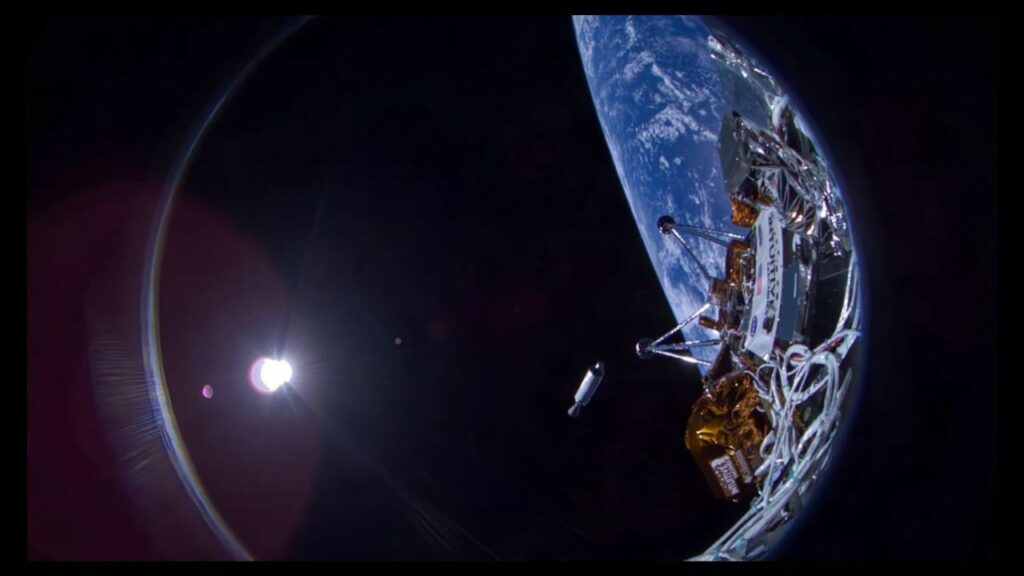Nasa’s private Odysseus: Odysseus Lander’s Beams home 1st photos from Space
Nasa’s private Odysseus – A groundbreaking lunar lander recently transmitted its initial images from space back to Earth. The Odysseus spacecraft, operated by Intuitive Machines, took several self-portraits with our planet in the backdrop soon after its launch on February 15 using a SpaceX Falcon 9 rocket. These images are now available for public viewing.

On February 16, 2024, Intuitive Machines announced the successful reception of the first batch of photographs from its IM-1 mission. These photos were taken just after the spacecraft detached from the Falcon 9’s second stage, marking Intuitive Machines’ inaugural voyage to the moon as part of NASA’s CLPS program. The company, based in Houston, shared this update along with four images on February 17 via a post on X.
Pioneering Lunar Exploration with Private Sector Partnerships
The Commercial Lunar Payload Services (CLPS) initiative is a groundbreaking program by NASA that leverages private sector capabilities to transport scientific instruments to the moon. These instruments, deployed on privately operated robotic lunar landers such as Odysseus, play a crucial role in supporting NASA’s Artemis program. The Artemis program’s objective is to establish a manned base near the moon’s south pole by the late 2020s, enhancing lunar exploration and research.
Odysseus is a key player in the current IM-1 mission, carrying six NASA experiments and technology demonstrations. In addition, it hosts six payloads from the private sector, showcasing the collaborative effort between NASA and private enterprises in advancing lunar exploration.

However, the journey to successful lunar landings through the CLPS initiative has seen its challenges. Before the IM-1 mission, the Peregrine lander, developed by Astrobotic, a Pittsburgh-based company, marked the first CLPS mission. Peregrine embarked on its lunar quest atop a United Launch Alliance Vulcan Centaur rocket. Despite a successful launch, the mission faced a setback when Peregrine experienced a fuel leak after detaching from the rocket’s upper stage. Unable to proceed to the moon, the lander was intentionally guided to disintegrate in the Earth’s atmosphere on January 18, highlighting the risks and uncertainties in space exploration.
Progress Report on Odysseus’ Moon Mission
Odysseus is on a promising trajectory, with its lander in good health and maintaining communication with the mission control team. It is on course for a moon landing attempt scheduled for February 22, as announced by Intuitive Machines.
The spacecraft’s various components are functioning as expected, with its engine system notably passing a critical test in the void of space.
Intuitive Machines’ flight controllers have successfully executed the inaugural space firing of an engine powered by liquid methane and liquid oxygen, marking the completion of the IM-1 mission’s engine commissioning phase. This significant engine test featured a full-power mainstage burn and a controlled throttle adjustment, crucial for a moon landing.

Achieving a successful landing on this mission would set a new milestone, as no privately-owned spacecraft has achieved a soft landing on the moon’s surface before.
Furthermore, it’s worth noting that Odysseus utilizes a propulsion system similar to SpaceX’s Raptor engines, which are designed for the company’s ambitious Starship rocket. Starship aims to transport humans to the moon and Mars and is gearing up for its third test flight soon.
The journey of Odysseus towards the lunar surface represents a significant leap forward in space exploration, especially for private entities venturing beyond Earth’s orbit. This mission, managed by Intuitive Machines, is not just a technical endeavor but a historic quest that could reshape our approach to space travel and lunar exploration.
As Odysseus progresses smoothly towards its destination, the mission control remains vigilant, ensuring the lander’s systems operate flawlessly. This meticulous preparation and execution underscore the complexity and challenges of landing on the moon, a feat that combines precision engineering with cutting-edge technology.

The successful firing of the liquid methane and liquid oxygen engine in the vacuum of space is a testament to the innovation and resilience of the team behind Odysseus. This engine, crucial for the descent and landing on the lunar surface, underwent a comprehensive commissioning phase, culminating in a full thrust mainstage burn and a detailed throttle down-profile. Such maneuvers are critical for the controlled and gentle landing required to prevent damage to the lander upon touchdown.
This propulsion technology, shared by SpaceX’s Raptor engines, signifies a broader shift in the space industry towards more efficient and potentially reusable rocket engines. The use of liquid methane and liquid oxygen as propellants not only offers high performance but also aligns with future missions’ sustainability goals, including those aimed at longer-duration lunar stays and missions to Mars.
The significance of a successful landing by Odysseus cannot be overstated. It would mark the first time a privately-owned spacecraft has achieved a soft landing on the moon, breaking new ground for private space exploration and potentially opening the moon to more frequent scientific missions and commercial ventures. This milestone would also demonstrate the viability of private companies playing a leading role in the next era of lunar exploration, working alongside national space agencies.
Moreover, the parallel development of SpaceX’s Starship, poised for its third test flight, highlights a burgeoning era in space exploration where ambitious projects are no longer the sole domain of government-funded space agencies. Starship’s development, aimed at enabling human exploration of the moon and Mars, exemplifies the growing synergy between private innovation and traditional space exploration goals.
The implications of these advancements extend beyond the immediate technological feats. They herald a future where space travel becomes more accessible and sustainable, facilitating a range of activities from scientific research to commercial exploitation of space resources, and eventually, human settlement on other celestial bodies.
As Odysseus approaches its historic landing attempt, the eyes of the world are watching. Success would not only crown a remarkable technical achievement but also reinforce the belief in collaboration between private and public sectors in conquering the final frontier. It would signify a step into a new era of space exploration, where the moon becomes not just a distant object of wonder but a gateway to the wider cosmos, opening up unimaginable possibilities for future generations.
In conclusion, the journey of Odysseus symbolizes the dawn of a new chapter in human space exploration. Through the combined efforts of Intuitive Machines, SpaceX, and other pioneers in the space industry, we are witnessing the unfolding of a new era where the moon and beyond become reachable, not just for a select few astronauts but potentially for all of humanity. The success of this mission would pave the way for further exploration, innovation, and perhaps one day, colonization of other planets, marking a monumental step in our quest to understand and inhabit the cosmos.
Other Links-
- Martians Wanted- NASA Invites Applications for Simulated Mars Year-Long
- NASAs Rover Captures Image of Solar Eclipse On Mars, See Photos
- NASA Telescopes Find New Clues About Mysterious Deep Space Signals
- Love in Space- US to Launch Next Moon Mission on Valentine Day










